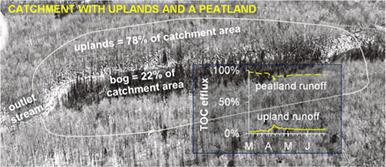当前位置:
X-MOL 学术
›
Hydrol. Process.
›
论文详情
Our official English website, www.x-mol.net, welcomes your
feedback! (Note: you will need to create a separate account there.)
Sources and biodegradability of dissolved organic matter in two headwater peatland catchments at the Marcell Experimental Forest, northern Minnesota, USA
Hydrological Processes ( IF 2.8 ) Pub Date : 2021-01-17 , DOI: 10.1002/hyp.14049 Stephen D. Sebestyen 1 , Meghan Funke 2 , James B. Cotner 2
Hydrological Processes ( IF 2.8 ) Pub Date : 2021-01-17 , DOI: 10.1002/hyp.14049 Stephen D. Sebestyen 1 , Meghan Funke 2 , James B. Cotner 2
Affiliation

|
Where they are present in catchments, peatlands are a dominant source of dissolved organic matter (DOM) to surrounding waterways due, in part, to high production rates. Despite the preponderance of peatlands in northern latitudes and expected peatland vulnerability to climate change, little is known about peatland DOM degradation relative to a more comprehensive understanding of degradation when DOM is sourced from upland‐dominated catchments. We compared DOM biodegradability of various sources of stream water in two catchments having peatlands (22%–33% of the area) surrounded by upland forests (70%–90% of the area, either deciduous or coniferous). We measured total organic carbon (TOC), and biodegradable dissolved organic carbon concentrations; bacterial respiration rates; streamflow; and upland runoff during and after snowmelt (March to June, 2009–2011). We also explored if DOM in upland runoff stimulated biodegradation of peatland‐derived DOM (i.e., a priming effect), and if forest cover type affected DOM biodegradability. As expected, the peatlands were the largest sources of both water (72%–80%) and TOC (92%–96%) to the streams although more area in each catchment was in uplands (70%–90%). Several results were unexpected, yet revealing: (1) DOM from peatlands sometimes had the same biodegradability as DOM from uplands, (2) upland sources of DOM had negligible effects on biodegradability in the peatland and downstream, and (3) upland deciduous cover did not yield more degradable DOM than conifer cover. The most pronounced effect of upland runoff was dilution of downstream TOC concentrations when there was upland runoff. Overall, the effects of upland DOM may have been negligible due to the overriding effect of the large amount of biodegradable DOM that originated in bogs. This research highlights that peatland‐sourced DOM has important effects on downstream DOM biodegradability even in catchments where upland area is substantially larger than peatland area.
中文翻译:

美国明尼苏达州北部马塞尔实验森林中两个水源泥炭地流域的溶解有机物来源和生物降解性
在集水区,泥炭地是周围水道中溶解有机物(DOM)的主要来源,部分原因是生产率高。尽管北部纬度的泥炭地占多数,并且预期泥炭地对气候变化的脆弱性,但相对于当人们从以山地为主的集水区获取DOM时对退化的更全面的了解,对于泥炭地DOM退化知之甚少。我们比较了两个被泥炭地(占面积的22%–33%)和高地森林(占落叶或针叶林的面积的70%–90%)的集水区中各种溪流水的DOM的生物降解性。我们测量了总有机碳(TOC)和可生物降解的溶解有机碳浓度;细菌呼吸率;水流; 融雪期间和融雪后(3月至6月,2009-2011)。我们还探讨了高地径流中的DOM是否刺激了泥炭地DOM的生物降解(即引发效应),以及森林覆盖类型是否影响DOM的生物降解性。正如预期的那样,泥炭地是河流中最大的水源(72%–80%)和TOC(92%–96%),尽管每个集水区中的更多地区位于山地(70%–90%)。几个结果出乎意料,但仍显示出:(1)泥炭地的DOM与高地的DOM具有相同的生物降解性;(2)陆地上的DOM对泥炭地和下游的生物降解性影响可忽略不计;(3)旱地的落叶覆盖确实不会产生比针叶树覆盖层更可降解的DOM。高地径流最明显的影响是当有高地径流时,下游TOC浓度被稀释。全面的,由于沼泽中大量可生物降解的DOM具有压倒性的作用,因此高地DOM的影响可以忽略不计。这项研究强调,即使在高地面积大于泥炭地面积的集水区中,泥炭地DOM对下游DOM生物降解也具有重要影响。
更新日期:2021-02-23
中文翻译:

美国明尼苏达州北部马塞尔实验森林中两个水源泥炭地流域的溶解有机物来源和生物降解性
在集水区,泥炭地是周围水道中溶解有机物(DOM)的主要来源,部分原因是生产率高。尽管北部纬度的泥炭地占多数,并且预期泥炭地对气候变化的脆弱性,但相对于当人们从以山地为主的集水区获取DOM时对退化的更全面的了解,对于泥炭地DOM退化知之甚少。我们比较了两个被泥炭地(占面积的22%–33%)和高地森林(占落叶或针叶林的面积的70%–90%)的集水区中各种溪流水的DOM的生物降解性。我们测量了总有机碳(TOC)和可生物降解的溶解有机碳浓度;细菌呼吸率;水流; 融雪期间和融雪后(3月至6月,2009-2011)。我们还探讨了高地径流中的DOM是否刺激了泥炭地DOM的生物降解(即引发效应),以及森林覆盖类型是否影响DOM的生物降解性。正如预期的那样,泥炭地是河流中最大的水源(72%–80%)和TOC(92%–96%),尽管每个集水区中的更多地区位于山地(70%–90%)。几个结果出乎意料,但仍显示出:(1)泥炭地的DOM与高地的DOM具有相同的生物降解性;(2)陆地上的DOM对泥炭地和下游的生物降解性影响可忽略不计;(3)旱地的落叶覆盖确实不会产生比针叶树覆盖层更可降解的DOM。高地径流最明显的影响是当有高地径流时,下游TOC浓度被稀释。全面的,由于沼泽中大量可生物降解的DOM具有压倒性的作用,因此高地DOM的影响可以忽略不计。这项研究强调,即使在高地面积大于泥炭地面积的集水区中,泥炭地DOM对下游DOM生物降解也具有重要影响。











































 京公网安备 11010802027423号
京公网安备 11010802027423号